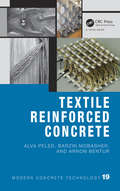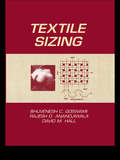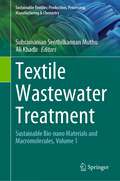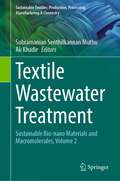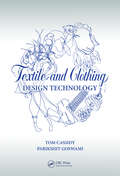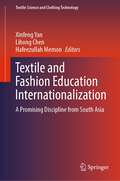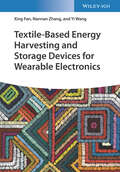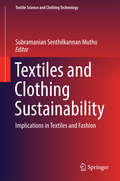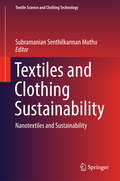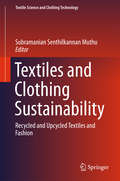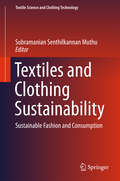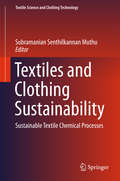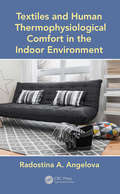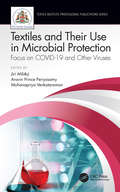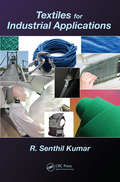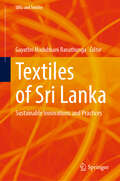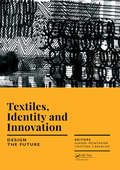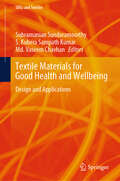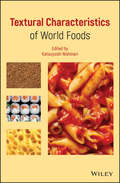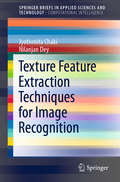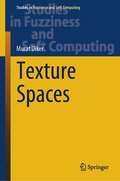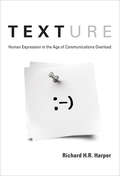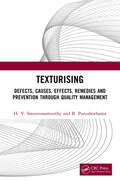- Table View
- List View
Textile Reinforced Concrete (Modern Concrete Technology #19)
by Alva Peled Arnon Bentur Barzin MobasherTextile reinforced concrete (TRC) has emerged in recent years as an attractive new high performance cement-based composite. Textiles can significantly improve the mechanical behavior of cement matrices under static and dynamic conditions, and give superior tensile strength, toughness, ductility, energy absorption and protection against environmental degrading influences. Flexibility with fabric production methods enables the control of fabric and yarn geometry. This, along with the ability to incorporate into the fabric a range of yarns of different types and performances, as well as cement matrix modifications, enables design of the composite to a wide range of needs. The book is intended to provide a comprehensive treatment of TRC, covering the basic fundamentals of the composite material itself and the principles governing its performance on a macro-scale as a component in a structure. It provides in-depth treatment of the fabric, methods for production of the composite, the micro-mechanics with special attention to the role of bonding and microstructure, behavior under static and dynamic loading, sustainability, design, and the applications of TRC composites.
Textile Sizing
by David Hall Bhuvenesh C. Goswami Rajesh D. AnandjiwalaHelping you keep pace with rapid developments in the field, Textile Sizing documents the rapidly changing scenario in textile processing and research in sizing. The authors analyze new fibers, spinning methods, and weaving techniques affecting textile production and studies the impact of fiber properties, yarn quality, sizing processes and material
Textile Wastewater Treatment: Sustainable Bio-nano Materials and Macromolecules, Volume 1 (Sustainable Textiles: Production, Processing, Manufacturing & Chemistry)
by Subramanian Senthilkannan Muthu Ali KhadirIn this first volume, various materials such as chitosan, lignin-based biomaterials, cellulosic based bio materials, carbon materials, Polysaccharide-composites materials, Aromatic-Based Synthetic Macromolecules, Agricultural wastes, etc for treating textile waste water are highlighted. One of the major pollutants in the textile and fashion industry is (textile) waste water. Textile wastewater can lead to serious environmental issues if discharged without proper and sufficient treatment. The materials employed along with the technologies available to trate waste water are the key. There are a lot of advancements in terms materials, technologies employed for textile waste water treatment. Sustainable bio-nano materials and macro molecules play a major role in the efficient treatment of textile waster.
Textile Wastewater Treatment: Sustainable Bio-nano Materials and Macromolecules, Volume 2 (Sustainable Textiles: Production, Processing, Manufacturing & Chemistry)
by Subramanian Senthilkannan Muthu Ali KhadirIn this second volume, various materials such as Magnetic-based biocomposites, wheat bran/straw-based biomaterials, peel-based biomaterials, luffa Based Biomaterials, composite polymeric membranes, rice husk, hydroxyapatite etc for treating textile waste water are highlighted. One of the major pollutants in the textiles and fashion sector is textile waste water. Textile wastewater can lead to serious environmental issues if discharged without proper and sufficient treatment. The materials employed along with the technologies available to trate the waste water are the key. There are a lot of advancements in terms materials, technologies employed for textile waste water treatment. Sustainable bio-nano materials and macro molecules play a major role in the efficient textile waste treatment.
Textile and Clothing Design Technology
by Tom Cassidy and Parikshit GoswamiIn the textile industry, there is a pressing need for people who can facilitate the translation of creative solutions from designers into manufacturing language and data. The design technologist has to understand the elements and principles employed by designers and how these change for various textile media. One must also have a good understanding of the processes, materials and products for which the textile designer is required to produce creative solutions. This book will be for designers wishing to improve their technological knowledge, technologists wishing to understand the design process, and anyone else who seeks to work at this design-technology interface. Key Features: • Provides a comprehensive information about textile production, apparel production and the design aspects of both textile and apparel production. • Fills the traditional gap between design and manufacture changing with advanced technologies. • Includes brief summary of spinning, weaving, chemical processing and garmenting. • Facilitates translation of creative solutions from designers into manufacturing language and data. • Covers set of workshop activities.
Textile and Fashion Education Internationalization: A Promising Discipline from Southeast Asia (Textile Science and Clothing Technology)
by Hafeezullah Memon Xinfeng Yan Lihong ChenThis book explains the past, present, and future of textile, fashion, apparel, and related majors of South Asian countries. The chapters express the hidden potential of textiles in South Asia. In this book, experts in textile engineering of each country describe the potential and prospects of textile education and how it can lead to internationalization. The book contains updated new illustrations, images, data, graphs, and tables. It also discusses the textile university alliance and the potential for international education related to textiles in the developing region.
Textile-Based Energy Harvesting and Storage Devices for Wearable Electronics
by Yi Wang Xing Fan Nannan ZhangDiscover state-of-the-art developments in textile-based wearable and stretchable electronics from leaders in the field In Textile-Based Energy Harvesting and Storage Devices for Wearable Electronics, renowned researchers Professor Xing Fan and his co-authors deliver an insightful and rigorous exploration of textile-based energy harvesting and storage systems. The book covers the principles of smart fibers and fabrics, as well as their fabrication methods. It introduces, in detail, several fiber- and fabric-based energy harvesting and storage devices, including photovoltaics, piezoelectrics, triboelectrics, supercapacitors, batteries, and sensing and self-powered electric fabrics. The authors also discuss expanded functions of smart fabrics, like stretchability, hydrophobicity, air permeability and color-changeability. The book includes sections on emerging electronic fibers and textiles, including stress-sensing, strain-sensing, and chemical-sensing textiles, as well as emerging self-powered electronic textiles. Textile-Based Energy Harvesting and Storage Devices for Wearable Electronics concludes with an in-depth treatment of upcoming challenges, opportunities, and commercialization requirements for electronic textiles, providing valuable insight into a highly lucrative new commercial sector. The book also offers: A thorough introduction to the evolution from classical functional fibers to intelligent fibers and textiles An exploration of typical film deposition technologies, like dry-process film deposition and wet-process technologies for roll-to-roll device fabrication Practical discussions of the fabrication process of intelligent fibers and textiles, including the synthesis of classical functional fibers and nano/micro assembly on fiber materials In-depth examinations of energy harvesting and energy storage fibers, including photovoltaic, piezoelectric, and supercapacitor fibers Perfect for materials scientists, engineering scientists, and sensor developers, Textile-Based Energy Harvesting and Storage Devices for Wearable Electronics is also an indispensable resource for electrical engineers and professionals in the sensor industry seeking a one-stop reference for fiber- and fabric-based energy harvesting and storage systems for wearable and stretchable power sources.
Textiles and Clothing Sustainability: Implications in Textiles and Fashion
by Subramanian Senthilkannan MuthuThis book comprehensively covers the topic of sustainability in the clothing and fashion sector. Sustainability is applied under different industrial sectors and there has to be a distinction in every industrial sector when it comes to sustainability in its application. Though the definition is common for sustainability, sustainability in the clothing sector has its unique objectives, principles, and limitations, which this book highlights.
Textiles and Clothing Sustainability: Nanotextiles and Sustainability
by Subramanian Senthilkannan MuthuThis book highlights the sustainability aspects of textiles and clothing sector in light of nanomaterials and technologies. The invasion of nano in every industrial sector has been important and has made remarkable changes as well as posed new challenges, including the textiles and clothing sector. There is quite a great deal of research happening in terms of nano materials for textiles across the globe, some of which are covered in this book.
Textiles and Clothing Sustainability: Recycled and Upcycled Textiles and Fashion
by Subramanian Senthilkannan MuthuThis book discusses in detail the concepts of recycling and upcycling and their implications for the textiles and fashion sector. In addition to the theoretical concepts, the book also presents various options for recycling and upcycling in textiles and fashion. Although recycling is a much-developed and widely used concept, upcycling is also gaining popularity in the sector.
Textiles and Clothing Sustainability: Sustainable Fashion and Consumption
by Subramanian Senthilkannan MuthuThis is the first book to introduce and explain the concept of sustainable consumption with reference to the clothing sector. It uses various case studies to detail sustainable consumption behavior in the industry. Consumption is a key issue and is a major driver when it comes to sustainability in any industry, including clothing sector. Several studies which have highlighted the need for sustainable consumption in the clothing sector are discussed in this book.
Textiles and Clothing Sustainability: Sustainable Textile Chemical Processes
by Subramanian Senthilkannan MuthuThis book highlights the challenges in sustainable wet processing of textiles, natural dyes, enzymatic textiles and sustainable textile finishes. Textile industry is known for its chemical processing issues and many NGO’s are behind the textile sector to streamline its chemical processing, which is the black face of clothing and fashion sector. Sustainable textile chemical processes are crucial for attaining sustainability in the clothing sector. Seven comprehensive chapters are aimed to highlight these issues in the book.
Textiles and Human Thermophysiological Comfort in the Indoor Environment
by Radostina A. AngelovaTextiles and Human Thermophysiological Comfort in the Indoor Environment delivers a methodical assessment of textile structures for various applications in the indoor environment with respect to the thermophysiological comfort of the inhabitants. The book begins by offering an overview of the role of indoor textiles and clothing as a barrier betwee
Textiles and Their Use in Microbial Protection: Focus on COVID-19 and Other Viruses (Textile Institute Professional Publications)
by Aravin Prince Periyasamy Mohanapriya Venkataraman Jiri MilitkýTextiles and Their Use in Microbial Protection: Focus on COVID-19 and Other Viruses provides readers with vital information about disinfection mechanisms used in textile applications in the fight against dangerous microbes and viruses. KEY FEATURES: Introduces the basics of textile materials used for medical applications Features key information on virology, characterization, indication, and passivation of COVID-19 Describes UV, photocatalysis, photooxidation, application of TiO2, copper-based viral inhibition, and activated carbon Discusses antiviral finishes for the protection against SARS-CoV-2, particle penetration in dense cotton fabrics under swollen state, and the impact of moisture on face masks and their designs Aimed at textile and materials engineers as well as readers in medical fields, this text offers a comprehensive view of fundamentals and solutions in the use of textiles for microbial protection.
Textiles for Industrial Applications
by R. Senthil KumarAn evolution is currently underway in the textile industry and Textile for Industrial Applications is the guidebook for its growth. This industry can be classified into three categories-clothing, home textile, and industrial textile. Industrial textiles, also known as technical textiles, are a part of the industry that is thriving and showing great
Textiles of Sri Lanka: Sustainable Innovations and Practices (SDGs and Textiles)
by Gayathri Madubhani RanathungaThis book highlights the role of sustainable development in ancient practices to modern innovations in the textiles of Sri Lanka. It reveals the textile of Sri Lanka from the historical age to current tech-fabrics. Supporting the sustainable development goals, this book covers the most sought-after concepts and practices in textile industry of Sri Lanka such as of maximum utilization, zero waste, eco-friendly production process, reuse, upcycling, recycling, and longevity. Various topics covered in this book are indigenous cultural textiles, women empowerment, agro-waste utilization, secondhand-fashion consumption, and many more. The book is a valuable reference for beginners, university students, researchers, and professionals interested in sustainable development in textiles and allied fields.
Textiles, Identity and Innovation: Proceedings of the 1st International Textile Design Conference (D_TEX 2017), November 2-4, 2017, Lisbon, Portugal
by Gianni Montagna; Cristina CarvalhoD_TEX presents itself as a starting point at a crossroads of ideas and debates around the complex universe of Textile Design in all its forms, manifestations and dimensions. The textile universe, allied to mankind since its beginnings, is increasingly far from being an area of exhausted possibilities, each moment proposing important innovations that need a presentation, discussion and maturation space that is comprehensive and above all inter- and transdisciplinary. Presently, the disciplinary areas where the textile area is present are increasing and important, such as fashion, home textiles, technical clothing and accessories, but also construction and health, among others, and can provide new possibilities and different disciplinary areas and allowing the production of new knowledge. D_TEX proposes to join the thinking of design, with technologies, tradition, techniques, and related areas, in a single space where ideas are combined with the technique and with the projectual and research capacity, thus providing for the creation of concepts, opinions, associations of ideas, links and connections that allow the conception of ideas, products and services. The interdisciplinary nature of design is a reality that fully reaches the textile material in its essence and its practical application, through the synergy and contamination by the different interventions that make up the multidisciplinary teams of research. The generic theme of D_TEX Textile Design Conference 2017, held at Lisbon School of Architecture of the University of Lisbon, Portugal on November 2-4, 2017, is Design the Future, starting from the crossroads of ideas and debates, a new starting point for the exploration of textile materials, their identities and innovations in all their dimensions.
Textile Materials for Good Health and Wellbeing: Design and Applications (SDGs and Textiles)
by Subramanian Sundaramoorthy S. Kubera Sampath Kumar Md. Vaseem ChavhanThis book explores the application of latest technologies such as nanotechnology, composite technology, biotechnology in textile materials for health-related applications. It further discusses different types of textiles and their application in the areas of health, safety and well-being. Various topics covered in this book are, medical textiles, filtration textiles, protective textiles, thermal protective wear, intelligent textiles and many more. The book also deals with air and water filtration textiles and textile-based personal protective equipments. This book will be of interest for students, researchers and professionals working in the area of textile engineering, materials, biomedical engineering, defense, healthcare and other allied fields.
Textual Intercourse
by Laura SabaForget instant messaging and e-mail?we are undergoing a text message revolution Text messaging is the newest and preferred wave of communication for the younger demographic and the number one application of cell phones. The market is ripe for this relationship guide for texters With this new trend come all kinds of questions and confusion concerning textual communication and protocol within relationships girls never would have imagined a generation ago. Tantalizing topics include: ? The dos and donOCOts of texting your significant other? Interpreting exactly what his text messages mean? Finding the right balance between texting and in-person communication? The ins and outs of building textual confidence? The art of textual flirtation? And so much more This revealing and useful book demonstrates exactly how those tiny text messages you send today can create big success for your love life tomorrow. "
Textual Poachers: Television Fans and Participatory Culture
by Henry JenkinsThe culture of fanfiction.
Textural Characteristics of World Foods
by Katsuyoshi NishinariA complete guide to the textural characteristics of an international array of traditional and special foods It is widely recognized that texture has an intrinsic relationship to food preference. A full understanding of its functions and qualities is, therefore, of crucial importance to food technologists and product developers, as well as those working towards the treatment of dysphagia. Textural Characteristics of World Foods is the first book to apply a detailed set of criteria and characteristics to the textures of traditional and popular foods from across the globe. Structuring chapters by region, its authors chart a journey through the textural landscapes of each continent’s cuisines, exploring the complex and symbiotic relationships that exist between texture, aroma, and taste. This innovative text: Provides an overview of the textural characteristics of a wide range of foods Includes descriptions of textures and key points of flavor release Examines the relationships between the texture, taste, and aroma of each food presented Is structured by geographic region Rich with essential insights and important research, Textural Characteristics of World Foods offers all those working in food science and development a better picture of texture and the multifaceted role it can play.
Texture Feature Extraction Techniques for Image Recognition (SpringerBriefs in Applied Sciences and Technology)
by Nilanjan Dey Jyotismita ChakiThe book describes various texture feature extraction approaches and texture analysis applications. It introduces and discusses the importance of texture features, and describes various types of texture features like statistical, structural, signal-processed and model-based. It also covers applications related to texture features, such as facial imaging. It is a valuable resource for machine vision researchers and practitioners in different application areas.
Texture Spaces (Studies in Fuzziness and Soft Computing #411)
by Murat DikerThis book provides a complete framework for the fundamental concepts and results of texture spaces and its applications. The principal aim is to present a comprehensive arguments due to connections among the textures, fuzzy sets and rough sets. In this context, direlations, fuzzy direlations and fuzzy relations constitute a bridge for the remarkable observations on rough set theory. In a more general setting, the approximation operators are also inspected for fuzzy rough set models with two domains of discourse. Since the book is self-contained and reader-friendly, the respected researchers may utilize this source for further investigations of the necessary results for their studies on rough set theory using textures. Therefore, prospective readers are not only mathematicians who interest in purely mathematical theories related to textures, but also engineers of information sciences who need more information for their interdisciplinary studies with respect to rough sets and fuzzy sets.
Texture: Human Expression in the Age of Communications Overload (The\mit Press Ser.)
by Richard H. HarperWhy we complain about communication overload even as we seek new ways to communicate.Our workdays are so filled with emails, instant messaging, and RSS feeds that we complain that there's not enough time to get our actual work done. At home, we are besieged by telephone calls on landlines and cell phones, the beeps that signal text messages, and work emails on our BlackBerrys. It's too much, we cry (or type) as we update our Facebook pages, compose a blog post, or check to see what Shaquille O'Neal has to say on Twitter. In Texture, Richard Harper asks why we seek out new ways of communicating even as we complain about communication overload.Harper describes the mistaken assumptions of developers that “more” is always better and argues that users prefer simpler technologies that allow them to create social bonds. Communication is not just the exchange of information. There is a texture to our communicative practices, manifest in the different means we choose to communicate (quick or slow, permanent or ephemeral).
Texturising: Defects, Causes, Effects, Remedies and Prevention through Quality Management
by H. V. Sreenivasamurthy B. PurushothamaDrawing on the expertise of both academic and industry professionals, this book details all the fundamental aspects of yarn texturizing technology. From the origins of texturizing to machinery types, process control, quality testing, and management systems, the topics covered in this book serves as a guide to understanding and improving industry practices. Focusing on common challenges and solutions, this book is aimed at students studying man-made fibers and textiles, as well as shop-floor personnel navigating the day-to-day issues of texturizing units in India. The subject matter of this book also discusses: Types and Advantages of Texturised Yarns Work and Total Quality Management Training and Education of People on Work Wickability Tests Evaluation of Physical Bulk of Air-Texturised Yarns Print edition not for sale in South Asia (India, Sri Lanka, Nepal, Bangladesh, Pakistan or Bhutan)
